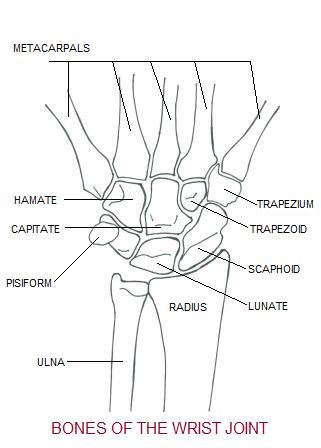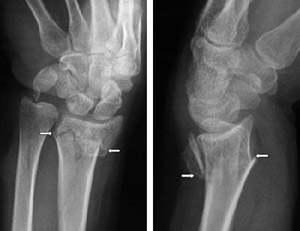
A fracture of the wrist is one of the most common types of fractures presenting to emergency rooms today, and the frequency of these fractures is increasing. In those over age 65, wrist fractures account for 18% of all fractures.
Anatomy
The wrist is made up of small bones collectively called the carpal bones, and two larger bones called the radius and the ulna. The radius and ulna are long bones that extend from the elbow to the wrist, and it is the end of the radius close to the wrist (or the distal radius) that is most frequently fractured.

Bony anatomy of the wrist. The end of the radius is the most commonly fractured bone in the wrist.
Mechanism of Injury
The most common cause of distal radius fractures is a fall onto your outstretched wrist. In younger folks with healthy bone, a fair amount of force is required to break this bone, such as a fall from a bicycle or a ladder onto an outstretched wrist. As we get older, the strength of our bones often is diminished (osteopenia or osteoporosis). As a result, in an older person, a simple fall from standing or walking can result in a distal radius fracture.

X-rays of a fractured distal radius
Treatment
Most breaks of the distal radius can be treated conservatively, either with casts or splints, for about six weeks. This is certainly the case for fractures that are non-displaced (the bone has cracked but has not shifted) and for many minimally displaced fractures (the bone has cracked and shifted only a little bit). Significantly displaced distal radius fractures are often treated with a closed reduction (manually pushing the bones back into place, with anesthesia). Some fractures are unstable, which means that even though the bones are pushed back onto place, the proper alignment won’t hold. In elderly individuals and those with low demands on the wrist, perfect alignment of the bones often is not necessary in order to perform normal tasks, such as caring for one’s self, hygiene, knitting, etc. Patients with higher demands—younger people, athletes, musicians, and artists—will benefit from perfect (anatomic) alignment, and surgical fixation is more often recommended in these individuals to restore function and maintain quality of life.
If surgery is recommended, the procedure is usually performed as an outpatient surgery (go home from the hospital the same day) and the procedure takes about an hour. The bones are stabilized using a metal plate and screws (often titanium) that are placed deep on the bone, often such that it cannot be felt by the patient. Results are very good and most patients have restoration of nearly all function. Some patients benefit from therapy for a few weeks after surgery, but this is determined on a case-by-case basis. Because the bones are stabilized by the internal metal plate, recovery is quick, and many patients are back to desk work within a few days. The metal plates and screws usually stay in the wrist forever, unless there is a medical reason to remove the metal or if the patient desires hardware removal. Complications are rare and the results are very good with this procedure.
Prevention
Of course, the best way to avoid a distal radius fracture is not to fall in the first place. However, we all know that this is not possible or practical. The best thing you can do to avoid a fracture is to maintain strong, healthy bones.
A healthy diet with the appropriate amount of calcium and vitamin D is a good first step to maintaining strong bones. Dairy, fruits, and vegetables are important. Enjoying an active lifestyle, with plenty of weight-bearing activity, is also essential to maintaining healthy bones. In some circumstances, your doctor may recommend medications to improve bone strength.
Weakening of the bones, due to aging or other medical conditions, is called osteopenia. Osteoporosis is the name of the condition once bone deterioration exceeds a defined threshold, as measured by DEXA (Dual Energy X-ray Absorptiometry) scan. DEXA scan measures bone density, which is similar to an x-ray. DEXA scan is a screening tool to determine bone density. Based on DEXA scan results, one-third of Caucasian women over age 65 are osteoporotic. Osteoporosis is more common in women, Caucasians, and Asians.
Summary
Distal radius fractures are common, and can often be treated with simple cast immobilization. In some circumstances, surgery is recommended to optimize function and recovery. A healthy diet and healthy lifestyle is critical to maintaining proper bone density and bone health.
 Dr. David P. Moss is an orthopaedic surgeon at Washington Orthopaedics & Sports Medicine, with specializations in conditions of the hand, wrist, and elbow. He is certified by the American Board of Orthopaedic Surgery and the American Society for Surgery of the Hand. Dr. Moss’ research interests include tennis elbow, carpal tunnel syndrome, and post-operative pain relief.
Dr. David P. Moss is an orthopaedic surgeon at Washington Orthopaedics & Sports Medicine, with specializations in conditions of the hand, wrist, and elbow. He is certified by the American Board of Orthopaedic Surgery and the American Society for Surgery of the Hand. Dr. Moss’ research interests include tennis elbow, carpal tunnel syndrome, and post-operative pain relief.
Want to know more?
For more information about wrist fractures, email us or request an appointment. Be sure to follow us on Facebook and Twitter as well!
